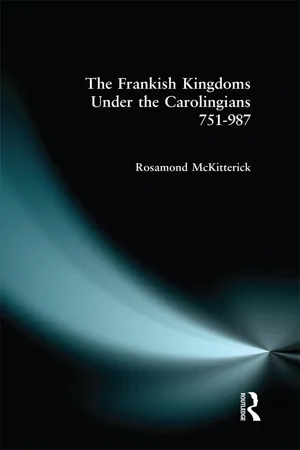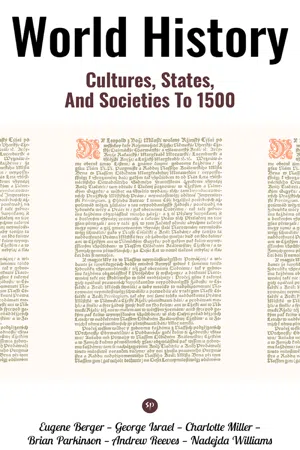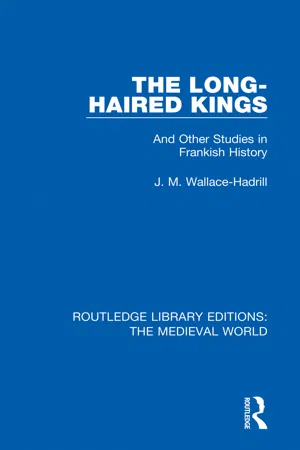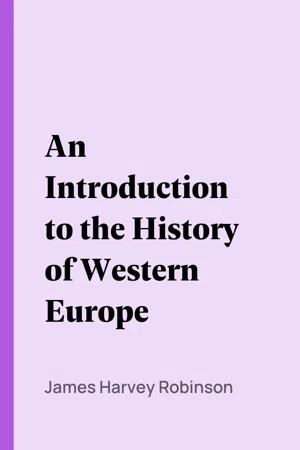History
The Franks
The Franks were a Germanic tribe that played a significant role in the early medieval period, particularly in the formation of the Frankish Kingdom and the Carolingian Empire. Under the leadership of figures like Clovis I and Charlemagne, the Franks expanded their territory and exerted influence over much of Western Europe, leaving a lasting impact on the region's history and culture.
Written by Perlego with AI-assistance
Related key terms
7 Key excerpts on "The Franks"
- Rosamond Mckitterick(Author)
- 2018(Publication Date)
- Routledge(Publisher)
rex francorum : the Emergence of the CarolingiansBy 613, when the Arnulfing or Carolingian family is mentioned for the first time in the Chronicle of Fredegar, the ruling dynasty of Frankish kings, the Merovingians, had ruled a mixed population in Gaul, mostly composed of Franks and 'Gallo-Romans' for over a century. Gaul had become an important, and rich, province of the Roman Empire after its conquest by Julius Caesar, and since that time many Romans, aristocrats, army veterans and civilians from south of the Alps had settled or had been settled there. They mingled with the indigenous Celtic population to some extent and a mixed Roman and Gallic ruling class emerged, of which the senatorial aristocracy and the bishops were the acknowledged leaders. The Franks, a confederacy of Germanic peoples of obscure origin, make their first appearance in the literary sources in the third century. They are mentioned in the context of the great barbarian invasion of Gaul during the reign of Gallienus; Aurelius Victor and Eutropius, for example, say The Franks crossed the Rhine near Cologne in about 257. The Franks were probably made up of small groups of those German tribes described in Tacitus's Germania. The Frankish people comprised several subgroups, the most important of which were the Salian Franks, who probably settled first in Belgium and who were permitted to occupy the region west of the Rhine as far south as the Loire, probably as foederati. (That is, they occupied Roman land on condition that they would only use their armies in the service of Rome. ) Gregory of Tours in his history of The Franks provides meagre information about different groups of Franks under 'subkings' who were conquered by Clovis;1- eBook - ePub
The Conquest of Saxony AD 782–785
Charlemagne's defeat of Widukind of Westphalia
- David Nicolle, Graham Turner(Authors)
- 2014(Publication Date)
- Osprey Publishing(Publisher)
Apocalypse. (Ms. 31, Stadtbibliothek, Trier)Here it is important to understand that the identities of these medieval gens or peoples were not ‘ethnic’ in the modern sense. They were merely a form of self and group identification, which rarely expressed any real sense of superiority over other gens. Nor was there as yet any conclusive association between states under one ruling dynasty and the gens, of which there were often more than one, within that state. The concept of the nation-state had, of course, yet to impose itself upon the world.Each of the main Germanic peoples also had its own origin myths, partially reflecting its own traditions and partly invented by southern churchmen or scholars who sought to incorporate these mysterious newcomers into the world of Mediterranean history and legend. Thus The Franks first appear in written Roman historical records in the 3rd century AD as a confederation of Germanic tribes, living along the lower and middle Rhine River. Some of them raided Roman territory while others sought service with the Roman army as laeti or allies. By the mid-4th century AD one group, known to the Romans as the Salian Franks, had established a virtually autonomous ‘kingdom’ within the Roman frontier. As the Western Roman Empire collapsed in the 5th century AD , these Salians united under the Merovingian dynasty and conquered most of Gaul (France) as well as the ex-Roman provinces of Raetia, Germania Superior and part of Germania Magna.The Meuse (Maas) Valley near Dinant in southern Belgium. During the 8th century AD this area formed part of the military heartland of the Carolingian state. (Author’s photograph)A small Old Saxon silver brooch in the form of a horseman c. AD 500. (Historical Museum, Nienburg; author’s photograph)By the later 8th century AD The Franks were ruled by the Carolingian dynasty, which had succeeded the Merovingians in AD - eBook - ePub
- George Adams(Author)
- 2017(Publication Date)
- Jovian Press(Publisher)
The Franks AND CHARLEMAGNE.................. IN THE ACCOUNT OF THE German conquest which was given in the fourth chapter the history of one tribe— The Franks—was entirely omitted. The results of their occupation of Gaul were so important, the empire which they founded, their alliance with the church, their legal notions and political institutions were all of such decisive influence upon the future that their history deserves a separate treatment. The ideas and practices of the Visigoths and of the Lombards had important results in the national history of the lands where they settled. It would be necessary to investigate Visigothic law in order to understand the details of Spanish institutional life. The Anglo-Saxons will doubtless exert upon the final political history of the world an influence greater than that of The Franks, if it be not already greater. But it was The Franks alone of all the German tribes who became a wide power in the general history of the middle ages. It is to them that the political inheritance of the Roman Empire passed, to them came the honor of taking up and carrying on, roughly, to be sure, and far less extensively and effectively, but nevertheless of actually carrying on the political work which Rome had been doing. They alone represent that unity which Rome had established, and so far as that unity was maintained at all as a definite fact, it is The Franks who maintained it - Eugene Berger, George Israel, Charlotte Miller, Brian Parkinson, Andrew Reeves, Nadejda Williams(Authors)
- 2018(Publication Date)
- Studium Publishing(Publisher)
exarch, or governor, in Ravenna (in northeastern Italy) would rule the city of Rome, even these Italian territories were gradually lost. Ravenna fell to the Lombards in 751; the duke of Naples ceased to acknowledge the authority of the emperor in Constantinople in the 750s; and the popes in Rome, long the de facto governors of the city, became effectively inde- pendent from Byzantium in the 770s. The popes in particular would increasingly look to another power to secure their city: The Franks.1 Modern historians use this label for convenience. At the time, both Churches in the Greek-speaking eastern Mediterranean and those following the pope would have said that they were part of the Catholic Church (the word catholic comes from a Greek word for “universal”). The churches in the eastern Mediterranean and Eastern Europe were coming to differ enough in terms of practice, worship, and thought that we can refer to them as distinct from the Catholic Church of Western Europe.Passage contains an image
Western Europe: The Rise of The Franks
Table of ContentsAt the west end of the Mediterranean and in northern Europe, the kingdom of The Franks would become the dominant power of the Christian kingdoms. Justinian’s armies had destroyed the Ostrogothic kingdom in Italy in the sixth-century Gothic War. A century and a half later, in 711, Arab Muslim invaders from North Africa conquered the Visigoth kingdom in Spain and established Muslim rule. From that time on, we refer to Muslim-ruled Spain of the early Middle Ages as al-Andalus. The destruction of these two kingdoms left The Franks as the dominant power of Western Europe. They were already the premier power in northern Gaul, but as the seventh century went on, they established themselves in southern Gaul as well, gradually subordinating other Germanic peoples to their rule.The first dynasty of Frankish kings was known as the Merovingians- eBook - ePub
The Long-Haired Kings
And Other Studies in Frankish History
- J.M. Wallace-Hadrill(Author)
- 2019(Publication Date)
- Routledge(Publisher)
CHAPTER ONE Frankish Gaul1 *The Franks who reached Gaul in the fifth century were a group of West German tribes from across the Rhine; tribes that had been in contact with Roman civilization for generations, the trusted soldiers of successive emperors. They were good soldiers, especially on foot, and clever in making and using arms (we know exactly what sort); they were good husbandmen, too; in brief, they were a long way from their nomadic origins. The only strange thing about them might seem to be that they were not Christians years before they set foot in Gaul; but such is the fact, and familiarity is not always the key to conversion. Further, it may be noticed that even combined with all the Visigoths and other barbarians, their numbers can have been only a fraction of the total population of Gaul; and that they had neither the desire nor the means to resist the process of romanization. They wanted to be Gallo-Romans, though in actual fact they became French; not, however, overnight, for what follows Gaul is not immediately France but sub-Roman Gaul, and sub-Roman it remains throughout certainly the first 150 years of Merovingian rule, and perhaps beyond. It is a society to which, a century after the coming of Clovis and his Franks, Gregory of Tours does not deem it necessary to explain what he means by civitas, pagus, territorium, vicus, villa, exactor, fiscus, indiculus, privilegium, rescriptum testamentum: the administrative shape of Frankish Gaul is for the most part sub-Roman and the men who run it use the old Latin terms, sometimes inaccurately but never with any sense of constraint. In the words of Einar Löfstedt, speaking of Merovingian Gaul, ‘before 600 the popular speech may be called Latin, after 800 Romance. For the intervening period either name will serve.’ And what is true of Frankish Gaul in the narrow sense (the greater part, that is, of old Gallia Comata - eBook - ePub
The Merovingians
Kingship, Institutions, Law, and History
- Alexander Murray(Author)
- 2022(Publication Date)
- Routledge(Publisher)
In English-language scholarship, see Patrick J. Geary, Before France and Germany: The Creation and Transformation of the Merovingian World (New York and Oxford, 1988), 85, 89, and cf. 94 (‘almost magical force of Merovingian blood’); and Ian Wood, The Merovingian Kingdoms, 450–751 (London and New York, 1994), 37 f., 40, 44; cf. his ‘Gregory of Tours and Clovis,’ Revue Belge de philologie et d’histoire 63 (1985): 267 n. Wood’s views may better be associated with older approaches rather than the recent perspective of German scholarship. The latter seems influential in a survey of a different kind: Michael Richter, The Formation of the Medieval West: Studies in the Oral Culture of the Barbarians (New York, 1994), 20. Edward James, The Franks (Oxford, 1988), 163, on the other hand, explicitly rejects Germanic myth as the origin of the Merovech tale. 2 For the intellectual foundations of sacral kingship theory, see Eve Picard, Germanisches Sakralkönigtum: Quellenkritische Studien zur Germania des Tacitus and zur altnordischen Überlieferung (Heidelberg, 1991). For comments and literature on some of the broader problems, of which sacral kingship is only a part, see Walter Goffart, ‘Two Notes on Germanic Antiquity Today,’ Traditio 50 (1995): 9–30. Primitive religious beliefs are commonly thought to be expressed through myth - eBook - ePub
- James Harvey Robinson(Author)
- 2008(Publication Date)
- Perlego(Publisher)
Translations and Reprints, Vol. IV, No. 3.CHAPTER X
THE DEVELOPMENT OF FRANCE
Importance of studying the beginnings of the modern European states.46. There is no more interesting or important phase of mediæval history than the gradual emergence of the modern national state from the feudal anarchy into which the great empire of Charlemagne fell during the century after his death. No one should flatter himself that he has grasped the elements of the history of western Europe unless he can trace in a clear, if general, way the various stages by which the states which appear now upon the map of Europe—the French republic, the German Empire, Austria-Hungary, and the kingdoms of Italy, Great Britain, and Spain—have grown out of the disorganized Europe of the ninth century.It might be inferred from what has been said in the preceding chapters that the political history of western Europe during the two or three centuries following the deposition of Charles the Fat was really only the history of innumerable feudal lords. Yet even if the kings of mediæval Europe were sometimes less powerful than some of their mighty subjects, still their history is more important than that of their vassals. It was the kings, and not their rivals, the dukes and counts, who were to win in the long run and to establish national governments in the modern sense of the term. It was about them that the great European states, especially France, Spain, and England, grew up.Struggle between the Carolingians and the house of Odo.As we have seen, the aristocracy of the northern part of the West-Frankish kingdom chose (in 888) as their king, in place of the incompetent Charles the Fat, the valiant Odo, Count of Paris, Blois, and Orleans. He was a powerful lord and held extensive domains besides the regions he ruled as count. But, in spite of his advantageous position, he found it impossible to exert any real power in the southern part of his kingdom. Even in the north he met with constant opposition, for the nobles who elected him had no idea of permitting him to interfere much with their independence. Charles the Simple, the only surviving grandson of Charles the Bald,[75]
Index pages curate the most relevant extracts from our library of academic textbooks. They’ve been created using an in-house natural language model (NLM), each adding context and meaning to key research topics.






